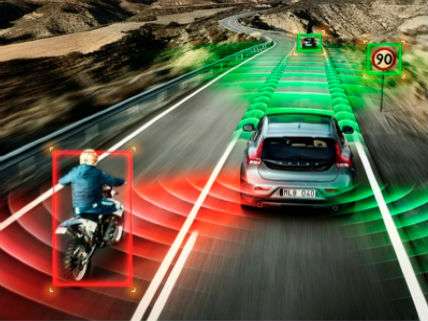Government Roadblock: Feds Should Just Get Out of the Way of Self-Driving Vehicles
"All government needs to do for the next transportation revolution [is to] get out of the road."

"I'm from the government and I'm here to help," declared U.S. Department of Transportation Secretary Anthony Foxx last week at the North American International Auto Show in Detroit. Well, Foxx didn't actually say that, but his statement was the moral equivalent when he unveiled the Obama Administration's proposal to spend $4 billion as an "investment" to accelerate vehicle automation. The precedents for such "investments" are not good. Why? Because, not at all surprisingly, bureaucrats (and their enablers in Congress) are not very good at picking technological winners.
For example, the big government thoroughly top-down idea a couple of decades ago was to combine relatively dumb cars with smart roads. So in the 1990s, the Feds "invested" $650 million in the National Automated Highway System. As a result of these investments, on July 22, 1999, a platoon of Buick LeSabres traveled more or less hands-free 7.5 miles down a specially designed section of Interstate 15. That was about it.
A decade and a half later, private companies have been hard at work figuring out how to make vehicles smart enough to safely navigate the government's still dumb roads. (It is true that the DARPA's $1 million robotic car Grand Challenge helped to jumpstart automated driving. Giving out prizes is a quite a bit different from "investing" in technologies.)
Over at Newsweek, Cato Institute transportation expert Randal O'Toole asks, "Why Is the Government Investing in Self-Driving Cars?" O'Toole points out that the Obama administration's vision still involves old-fashioned top-down thinking; specifically the construction of vehicle-to-infrastructure communications, i.e., smart roads.
O'Toole explains why this is retrograde thinking:
Foxx proposes to spend most of the $4 billion on a very different technology called "connected vehicle" or vehicle-to-infrastructure communications. In this system, the government would have to install new electronic infrastructure in all streets and highway that would help guide self-driving cars.
But states and cities today can't fill potholes or keep traffic lights coordinated, so they are unlikely to be able to install an entirely new infrastructure system in any reasonable amount of time.
Moreover, the fixed infrastructure used for connected corridors will quickly become obsolete. Your self-driving car will be able to download software upgrades while sitting in your garage overnight – Teslas already do so. However, upgrading the hardware for a connected vehicle system could take years and might never happen due to the expense of converting from one technology to another. Thus, Foxx's plan would lock us into a system that will be obsolete long before it is fully implemented.
Assuming that such a centralized transportation system could be developed, O'Toole also points out that it would enable government agents to comprehensively monitor your travels and even to control the car in which you are traveling.
O'Toole concludes:
If Congress approves Foxx's program, the best we can hope for is that Google and other private companies are able to ignore the new technology. The worst case is that the department's new rules not only mandate that cars be able to use connected streets, but that they work in self-driving mode only on roads that have connected-streets technology.
In that case, the benefits of self-driving cars will be delayed for the decades that it takes to install that technology–and may never happen at all if people don't the extra cost for cars that can drive themselves only on a few selected roads and streets.
All government needs to do for the next transportation revolution to happen is keep the potholes filled, the stripes painted and otherwise get out of the road. In contrast, Foxx's is a costly way of doing more harm than good.
Here's hoping that gridlock in Congress will derail this proposal.
O'Toole's article is well worth your attention, especially including his tart observations about the Obama administration's back-to-the-future embrace of 19th century transportation technologies such as trains and trolleys.


Show Comments (66)